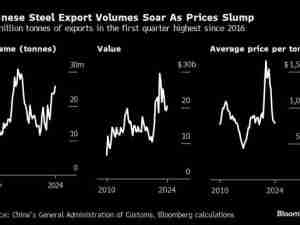Germany’s economy grew at the weakest pace in more than a year at the start of 2018, part of a slowdown across the euro area that the European Central Bank says may prove temporary.
The 0.3 percent expansion in the first quarter was softer than economists had forecast and just half the pace seen in the final three months of 2017. The statistics office said growth was driven by domestic demand, while trade lost momentum. From a year earlier, adjusted gross domestic product rose 2.3 percent.
The euro remained lower after the report and traded at $1.1923 at 8:45 a.m. Frankfurt time.
The slowdown in Europe’s biggest economy is further confirmation that the region had a sluggish start to the year, a development already apparent in business surveys and other indicators. Yet ECB officials have dismissed a deceleration of euro-zone momentum to 0.4 percent from 0.7 percent as a combination of factors such as a flu epidemic and colder weather and expect it to dissipate in the course of the year.
What Our Economists Say “Whether this marks the end of a robust expansion or is just a bump in the road is crucial to understand as the ECB mulls the end of asset purchases. We think a modest amount of momentum has been lost, but that 2Q will see a rebound.”—Jamie Murray and David Powell, Bloomberg Economics. See their full analysis here |
Speaking on Monday, ECB Governing Council member Francois Villeroy de Galhau said growth remains solid and broad-based and that policy makers were still likely to halt asset purchases this year. The European Commission has also indicated it’s not overly concerned and this month maintained its forecast that full-year growth will almost match the decade-high pace hit in 2017.
Still, threats ranging from trade tensions to higher oil prices and market volatility could act as a brake. Olli Rehn, the deputy governor of the Bank of Finland, said Monday that risks to the medium-term outlook “seem to be tilted on the downside.” The International Monetary Fund will update its view of Europe’s economy later on Tuesday.
The Bundesbank also remains optimistic, saying that record orders should boost German output in the coming months. Just last week, Siemens AG raised its outlook for full-year earnings, and HeidelbergCement AG said the economic upswing will boost construction activity in its major markets after a long winter held back first-quarter results.
Growth Drivers
Germany’s statistics office said growth at the start of the year was bolstered by a pickup in equipment investment and construction and a slight increase in private consumption. Government spending declined for the first time in almost five years, with exports and imports also down.
In China, data on Tuesday showed economic momentum broadly held up in April with industrial production exceeding forecasts, though slowing investment signaled a moderation in the coming months. Retail sales also rose less than expected.
In the euro area, Slovakia, the Netherlands and Portugal will also publish their first-quarter GDP data on Tuesday, while Eurostat’s second estimate for the 19-nation euro zone is due at 11 a.m. Frankfurt time. The ZEW institute will release its latest investor expectations index at the same time.





